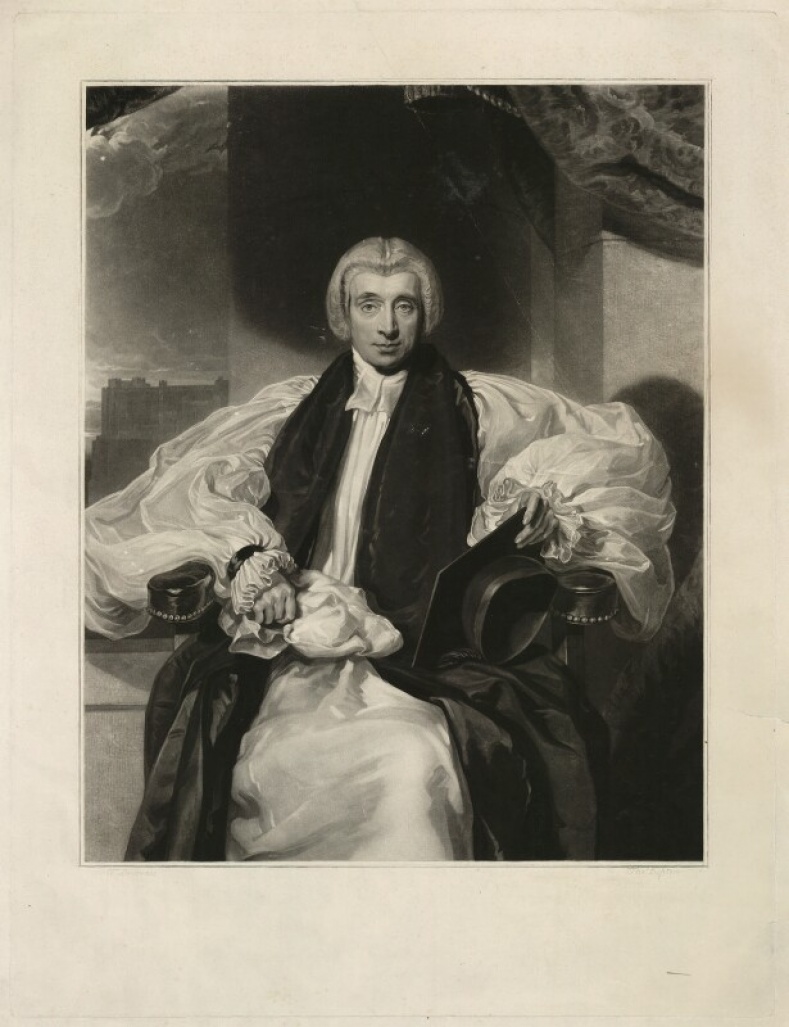
Van Mildert, Bishop William
1765 – 1836
Bishop of Durham and Founder of Durham University
William Van Mildert was the last pre-reform Bishop of Durham, in post between 1826 and 1836, to hold extensive secular as well as religious powers. County Durham was unique in post-conquest England in having royal powers over justice, taxation and the raising of arms ceded to its Bishop, giving rise to the popular notion of the county being ruled for centuries by a succession of ‘Prince Bishops’. In truth, the majority of the powers ceded during the post-conquest settlement had been withdrawn or eroded by the time of Van Mildert, but what had been retained was control of revenues from a vast landed estate. This made the Bishopric of Durham one of the most financially desirable and sought-after appointments within the Anglican Church.
William was the son of gin distiller Cornelius Van Mildert and his wife Martha. He was educated at St Saviour's School, Southwark, until 13 years old, and then at the Merchant Taylors' School. He entered Queen's College, Oxford in 1784, graduating with a BA in 1787 and an MA in 1790. He was ordained as a priest in 1789, and in 1813 was awarded the degrees of Bachelor and Doctor of Divinity by Oxford University. He served as a curate at Witham in Essex until 1795 when on the nomination of his brother-in-law he was appointed Rector of Bradden near Towcester. As was common practice at the time, Anglican clerics could hold several appointments conterminously, building up sizeable incomes. William Van Mildert was especially well connected in the City of London, enabling him to become chaplain to the Grocer’s company and Rector of St Mary-le-Bow in 1796. He proved himself a distinguished theologian lecturer and preacher. He was appointed Lady Moyer lecturer at St Paul’s in 1797 and between 1802 and 1804 preached the Boyle lectures refuting infidelity. More beneficial appointments ensued, including vicar of Farningham in Kent (1807-13) and preacher at Lincoln’s Inn. Many of his sermons were collected and reprinted. In 1813 he became Regius Professor of Divinity at Oxford with various ‘livings’ attached, all the while remaining Rector of St Mary-le-Bow.
William Van Mildert was a shrewd operator within mainstream, conservative Anglicanism, leading him to be elevated as Bishop of Llandaff in 1819 and then translated to the rich see of Durham in 1826. At Durham, he is celebrated as the founder of Durham University in 1832. The antecedents of this bold move are complex. New institutions of higher education, breaking the monopoly of Oxford and Cambridge, were now in vogue with the establishment of the secular University College London in 1826 and its Anglican counterpart, King’s College, London, in 1829. Durham had long cherished the idea of a university serving the North of England and decided the time was right to revive the project, encouraged in part by the prospect of Newcastle satisfying that ambition first. Making a pre-emptive move had the advantage of investing the called for northern university with a religious rather than a secular character. Moreover, there were compelling financial reasons to act. The same forces demanding political reform, leading to the Great Reform Act of 1832, were also demanding the reform of the Church of England. The old travesties of multiple office holding, political patronage and super-wide disparities in clerical incomes were under attack. Durham, with its super-rich prebendaries, members of the cathedral chapter with light duties and minimal attendance requirements, was an obvious target for reform. Diverting resources from prebends (effectively dissolving 4 of 10) to fund university appointments and making over cathedral buildings for university use presented an opportunity for voluntary reform in the face of the enforced reform that followed the establishment of the Ecclesiastical Commissioners in 1835.
In this moment of crisis and opportunity, William Van Mildert, strongly supported by Archdeacon Charles Thorp, proved himself a leader of courage and foresight, securing an enabling Act of Parliament in 1832. Much remained to be done to realize the vision, and over the next few years, van Mildert worked unwaveringly to this end, donating £2,000 each year to meet start-up costs and gifting books to help establish the University Library. His founding role was recognized at the time by the establishment of the Van Mildert Chair of Divinity, which remains in existence and remembered since 1965 through the establishment of Van Mildert College as a constituent part of the university.
References
Durham University. (2013). Van Mildert College: A Short History of Bishop William Van Mildert, Available here (Accessed 06/06/2018).
Varley, E.A. (2007). Mildert, William Van (1765–1836), bishop of Durham, Oxford Dictionary of National Biography, Available here (Accessed: 06/06/2018).
Whiting, C.E. (1932). The History of Durham University, 1832-1932. London: The Sheldon Press.
Wikipedia. (2018). Van Mildert College, Durham, Available here (Accessed 06/06/2018).
Wikipedia. (2018). Van Mildert Professor of Divinity, Available here (Accessed 06/06/2018).
Wikipedia. (2018). William Van Mildert, Available here (Accessed 06/06/2018).
Varley, E.A. (1992). The Last of the Prince Bishops: William Van Mildert and the High Church Movement of the Early Nineteenth Century. Cambridge: Cambridge University Press.